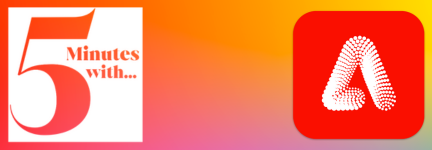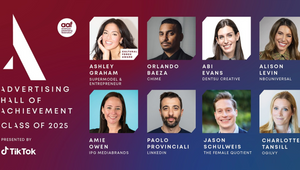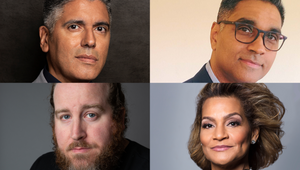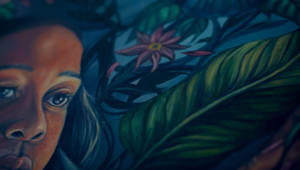
5 Minutes With… Mark Ringer

LBB editor Gabrielle Lott chats with Anthem! Worldwide’s new UK & Europe Executive Creative Director, Mark Ringer. On the agenda is the company’s transformation into a full-service agency, the joy of exploring London town, the power of self-belief and his momentous career that has seen both life and work in some of the world’s most exciting cities.
LBB> Tell us about Anthem! Worldwide. You’ve just joined in the last two months. What is it about Anthem! that has persuaded you to move from Hong Kong to join them here in London and what is it that makes the company such a ‘unique offering’?
MR> The really good reason for why I moved is because, increasingly, being an ECD at an advertising agency, you find that you aren’t far enough up stream to be able to influence all of your clients decisions. The great thing about joining a company like Anthem! is that I am at the headwater of the conversation. When a client is talking about their packaging, this is the moment from which all ideas can cascade. To be at that table is a great opportunity. Most people who do the job that I’ve been doing don’t get that. Anthem! offers that to me and as part of that, it’s about the company becoming a full-service agency. I am bringing package designers, designers and digital communications people together and taking them on this campaign journey.
LBB> It must, not only be extremely exciting, but a completely new creative thought process for you. How has that been?
MR> The first thing I have had to do is address the internal culture. Often people in design are a little more reserved, so it’s about building a culture of self-belief – that’s the first stage. Secondly, with the client, it means that every presentation I attend becomes a pitch, irrespective of what they’ve asked us to do, even with existing clients because we’re saying ‘here’s the capability and here’s what it can be’. Which is, excitingly, using all resources of the agency. It’s great. What that has done internally is get everyone working together that previously, because of his or her specialism, may have worked more independently.
LBB> Although you didn’t work on ‘Forever Ink’, it is one of the first products that the agency has launched from product design to a fully implemented communications strategy. Can you discuss the work in greater detail?
MR> In fact, the other week, I presented to our ‘Forever Ink’ client the entire 2013 plan. They had some budget that they wanted to use for communication, so they spoke to us and asked if they could use it and whether there was a deadline. We only launched Forever Ink a couple of weeks ago…
LBB> Yes, can you talk me through that process?
MR> Forever Ink came to us with a blank tube of the product and asked us to position it, assist with the naming and to not only design the packaging, but also work with the brand idea. To be fair that was done when the Anthem! model was in its infancy, before my arrival. So there were some things that we did very well, such as the packaging design, and the digital work… But the communication wasn’t quite there.
At the recent meeting with the client we discussed how we go forward with communications. It was really interesting hearing their response because you’re in defensive positions with clients. So many times in advertising agencies you’re defending yourself when there are clients sitting there rubbing their chins saying ‘I’ve got a few concerns’. In this instance, the client said ‘I always love what you present and this work is, without exception, really creative’. It’s interesting going on that journey, dealing slightly with a different part of the business, but using the same skills. It’s wonderful how it is received.
LBB> Creatives are often frustrated with the design of the product that they have to work with. To counteract that frustration, many agencies have been creating their own products… but at Anthem!…
MR> I think that the great thing about creative companies is they can create products – there is no doubt about that. We are never short of ideas and concepts. Quite often it is the distribution and other elements that act as barriers. I think it must be very satisfying to work on your own thing, but I worry that it could distract you from your core business - to communicate on behalf of your clients. I think for us, we are in that privileged position of being far enough upstream that it feels like it’s ours.
LBB> You’ve worked with big brands before - adidas, Levi, Volkswagen, BMW, Mercedes and Honda to name a few - and you’ve won many awards for your work. With clients that you’ve worked with over a period of time, you must gain brand loyalty and affiliation. But with Anthem!… does this feel more like you’re fostering your own child? Is there more of a personal connection?
MR> Interesting. I think that there is definitely a personal connection and you feel as though the business and the client’s business, is really dependent on you. So, there is a relationship there that could be slightly parental in its responsibility. It certainly feels that way – they are really relying on you. The packs have to talk before anything else. Of course, the future of Anthem! is not only in packs, we are talking about big ideas from the shelf out. It’s a great place to start because it’s the history of our company and it’s existing strength, but the shelf is really a metaphor and that can be for the car dealer show room, it can be for the branch… We hope to always maintain the upstream relationships. One of our biggest clients is British Airways, where we have an in-house division helping them with their communications. We also have Nestlé in York, which is very big. In fact, I’ve just seen some fabulous work for Yorkie to be released in 2013 which I believe will really make the market sit up and take notice – it’s going to be fabulous. So, for me it’s quite a rich experience.
LBB> You quote on your blog that you ‘left school at 17 and you’ve always felt over qualified’. How did you get into advertising?
MR> I had a placement for a couple of weeks during my school holidays, in Adelaide, where I grew up. My grandfather used to own an agency. He sold it and it became DMB&B, which over time became part of the Leo Burnett group. This was in the 80s, and my Grandad still had contacts there even though he’s retired. He got me in to do some work experience. I was just a dog’s body running around but I thought it was so much better than going to school. I decided to get myself into the industry as quickly as possible.
LBB> And your parents just said ‘yeah, go ahead’?
MR> No, but fortuitously there was a traineeship that was offered through the Australian government and the top twelve agencies in Adelaide. Two days of the week in a further education college, three days on the job. I submitted a folio and I was picked up by Y&R Adelaide. At the time, I think Lionel Hunt said that there were only three places to work in Australia – Sydney, Melbourne and Y&R Adelaide. I was really lucky to be picked up as a trainee there. So that’s how I started and one of the prerequisites was that you had to have finished school before you started. I was just embarking on my last year at school, but I got accepted. My parents thought about it and in their wisdom they let me go for it.
LBB> You started off in Adelaide, but you’ve worked in Sydney, Singapore, Melbourne, Hong Kong and now London. Can you talk us through that journey and your time at Batey? Also, we’re looking at incredibly different markets, how did you adapt?
MR> It’s funny, because creative people can inherently be very conservative. Some of them just don’t move, they just do the same thing and are quite comfortable with that. I find that cultures and movements are extremely stimulating. It doesn’t make it easy necessarily, but it makes it interesting. I moved to Sydney because I had to be there if I was going to work in Australia. I was so happy when I got a job in Sydney because I thought I was really clever (laughter).
I was at DDB and it was interesting because Shaun Branagan was one of the senior writers and I was one of the junior kids. There was also Matt Eastwood, he was a copywriter and he was paired with Shane Gibson. Mike Miller was there also and Paul Jones was the ECD.
He had done some beautiful work for Mcdonald’s, which put DDB at the top of my list. I was lucky to get a job there and then. After about 18 months, a friend of mine phoned from Singapore and said ‘It’s going to be really good here. I am at Batey and they’re investing and there are all these people from around the world here’. He and his copywriter Kash Sree were splitting up. Kash was going to work with Andy Fackrell and Scott Lambert, my partner said ‘come on up and work here, there are all of these great guys’. Jim Aitchison was running it. In the creative department there was Malcolm Price, who is an author now here in the UK, and his art director was Tan Kai Ming. Jay Furby and Paul Burnell - I think Paul had won the Grand Prix at Cannes at 25 and in the same year had won bachelor of the year. Tony Redman. Andy Clarke who’s now in NYC, but British. In fact, Andy was working with a guy called Mark Fong who’s one of Singapore’s best copywriters. David Holmes was running the Singapore Airlines group at Batey, at the time. It was an incredibly rich department to be in.
LBB> What time period are we looking at here?
MR> There was a window from between 1995 until about 1998 where all these people came together under one roof and then two things happened which changed the culture of the place and consequently everyone left.
LBB> We’re looking at a period in Singapore’s advertising history where it’s finally getting a worldwide voice and recognition. What was that like to be a part of?
MR> It was an extremely exciting time for me as I started to travel the world. I’d left Australia and I was beginning to explore, spending time, shooting in Europe. You could say that you came from Batey and it meant something. It really, really meant something. At the time, it was arguably considered the only independent agency that was really doing anything. Don’t get me wrong, there were other agencies in the region that were rewarded at the time; Bates in Hong Kong had a good time of it and there was the Ball partnership prior to that. Batey had a lot of energy in one place, at one time. People were really interested in hearing from you and it was a tough working environment, particularly for those at the top, it could be difficult to navigate direction. It was a card that opened a lot of doors at the time and looking back at it, I think it was because Ian Batey was preparing to sell. He wanted it to be sexy and he was never afraid to invest in creative talent. This is something, unfortunately, that hasn’t really been continued in the industry. It’s a global phenomenon that that level of investment is not there. His payroll must have been enormous at the time because Sean Boyle was a planner and there were many mangers; Americans, Brits, all GMs, MDs… it just went on and on. A very exciting time. I think we only left there, because culturally it broke up after a few hires that were made which meant a lot of people went there own way. It was a shame that we never went head-to-head with Saatchi & Saatchi. As David Droga arrived, Batey was breaking up and that’s when Saatchi & Saatchi took over the mantle in Singapore.
I did some time at DDB from Batey, which is when I got to work on Volkswagen. The reason I went there was because they told my art director and I, that if we came to DDB, we’d be the only team working on Volkswagen for the region. It was one of those things. At the time we were talking with David Droga about joining him, but to be the only team working on such a client…
After that I spent a little time at M&C Saatchi and then went back to Melbourne and spent some time at FCB. It was interesting because I didn’t really have creative director credentials. Of course, I had gone through group head phases, being a senior team, but I hadn’t worked within a CD role. I moved with Scott Lambert and we thought we’d give it a go and try together. Frankly, FCB Melbourne was the only place that would give us the opportunity. They had Honda for Australia and, although the network wasn’t much cop, in our little office it was creatively fine. It allowed me the springboard to go on and take the ECD role at TBWA Hong Kong.
LBB> How was that? To be ECD?
MR> Scott and I shared the role at FCB Melbourne, which was critical to our personal growth because I think we had another person to rely on. You could shut the door and say ‘are we handling this well?’ and you could fight things together. Then, inevitably we wanted to do our own thing. I wanted to move. I had been at FCB for four years, and Scott went on to stay for a total of eight. It was right for us, as we’d grown, to go on and do our own thing. TBWA is a fabulous network, irrespective of where it comes on awards ranking – which varies by market and by year, like any agency, but culturally it is one of the best. It offered me the opportunity to work, not just with TBWA locally, but with TBWA internationally under John Hunt, Emmanuel Andre and Jean-Marie Dru. To have these people who permeate the culture of the network all the time was just brilliant.
LBB> You were there for five and half years…
MR> The great thing about being the ECD of TBWA Hong Kong is that there are still regional structures. Whenever Tom Carroll or John Hunt visit the region, they always come through Hong Kong. Keith Smith is still there, the president international, he has two offices; one in Paris and one there. You get high exposure within the network. Hong Kong is an extremely tough market to do good creative work. The only creative work tends to be work that’s agency initiated on a small-scale. It’s a business market, much like Singapore. My theory (I could be completely wrong) is that because both Singapore and Hong Kong were founded in trade, there is a prevailing mentality of ‘How much is it?’ and ‘When can we have it?’ that permeates everything you do within advertising. Quality is third. I think where London is different is quality is inextricably linked to that equation and is ultimately what is driving it.
LBB> London is famous for it’s craft, historically. It’s interesting what you say about Hong Kong and that you’re now here in London…
MR> Really the bond of the local office and the network kept me in Hong Kong for such a long time – I really enjoyed it and it was still satisfying, but it was always frustrating. There was always a level of frustration and frankly that comes with working in Asia because of the way of doing business. It draws upon all your experience - you’ve got to be quick. You’ve got to be able to come up with fast solutions that are still good and are ideally great, which is exhausting. It’s like you go there with a full tank and eventually you hit empty. Whereas coming to London, it’s interesting what a great city it is for creative business services and what it gives you culturally.
Since I’ve been here, I’ve been able to do everything from the theatre, conferences on the paranormal in Oxford, I attended a bio-dynamic gardening and agriculture workshop last week, there’s the exhibitions – there are so many things to go to and do. You feel creatively invigorated every week. It gives a lot and that’s a very happy cycle. You give to the city and the city gives back. Also, the expectations of creativity and quality are much higher here. It’s really refreshing to be in the meetings that I’ve been in where clients are delighted by what’s being shown - rather than perhaps talking about the concerns that they have and worrying about time and money.
LBB> Talk me through the next 12 months and the plans that you have for Anthem in 2013…
MR> For the next few months Anthem! will be significantly increasing our visibility. But that won’t just be talking about how we are working and how we are building the company, it will be more on what we are producing. The work, it all comes down to the work. For the next six months I shall be a bit invisible but then we will have a lot of work breaking. As I mentioned earlier, we have a new campaign for Forever Ink, fingers crossed, and Yorkie next year. I have things lining up that I can already see but it’ll be six months before they’re released and before people start to see that Anthem! is an interesting creative company.
We are not hierarchically driven and we have more of a collaborative studio feel, there is no ego here. I think it’s going to give us a great opportunity to be fast and light and good and to really challenge some of the industries biggest players. The proof of that will be what we do over the next few months. I have a very big meeting this month, with a very big client that I can’t talk about – their business is mainly with advertising agencies. They’ve seen what we are doing upstream and then want to talk about what we can do. How we can, not only do that, but how we can cascade it through. Ask me in the summer where the work is and I’ll have plenty to show you.















